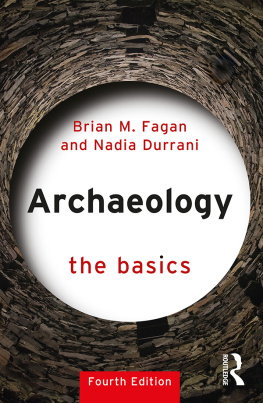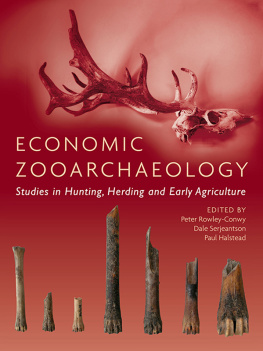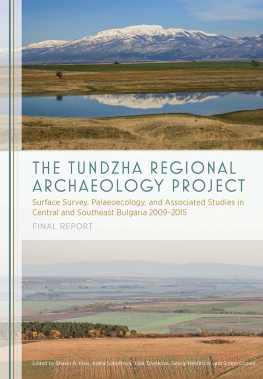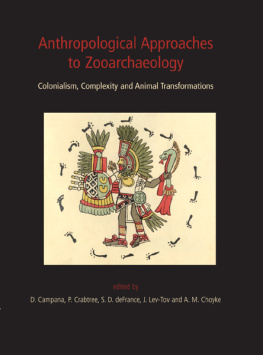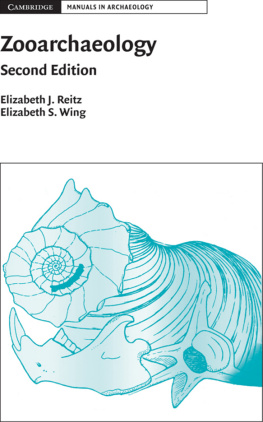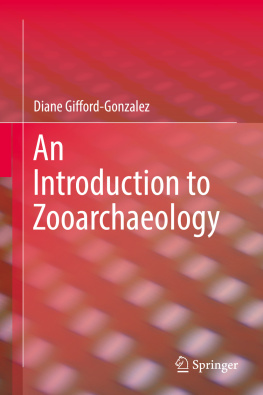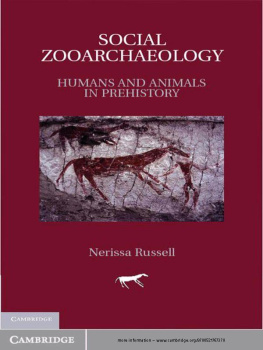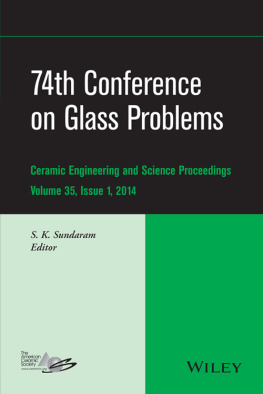RESEARCH PROBLEMS IN ZOOARCHAEOLOGY
RESEARCH PROBLEMS IN ZOOARCHAEOLOGY
edited by D.R. Brothwell
K.D. Thomas
Juliet Clutton-Brock
University College London Institute of Archaeology Publications, Vol. 20 Occasional Publication No. 3
Originally published by University College London Institute of Archaeology
First published 2009 by Left Coast Press, Inc.
Published 2016 by Routledge
2 Park Square, Milton Park, Abingdon, Oxon OX14 4RN
711 Third Avenue, New York, NY 10017, USA
Routledge is an imprint of the Taylor & Francis Group, an informa business
Copyright 1978 The Institute of Archaeology
All rights reserved. No part of this book may be reprinted or reproduced or utilised in any form or by any electronic, mechanical, or other means, now known or hereafter invented, including photocopying and recording, or in any information storage or retrieval system, without permission in writing from the publishers.
Notice:
Product or corporate names may be trademarks or registered trademarks, and are used only for identification and explanation without intent to infringe.
Library of Congress Cataloguing-in-Publication Data available from the publisher
ISBN 13: 978-0-90585-307-9 (pbk)
LIST OF CONTRIBUTORS
Dr P. L. Armitage | Department of Zoology, British Museum (Natural History), Cromwell Road, London SW7 |
Dr J. R. Baker | Clinical Pathology Unit, Veterinary Field Station, Leahurst, Neston Wirral, Cheshire L64 7TE |
Professor R. J. Berry | Royal Free Hospital School of Medicine, 8 Hunter Street, London WC1N IBP |
Mr D. R. Brothwell | Institute of Archaeology, 31-34 Gordon Square, London WC1H OPY |
Dr R. A. D. Cameron | Department of Extra Mural Studies, University of Birmingham, P.O. Box 363, Edgbaston, Birmingham B15 2TT |
Miss J. Coy | Department of Archaeology, University of Southampton, Southampton S09 5NH |
Mrs S. Denford | 99 Wildmeadow Road, London SE6 |
Miss M. Girling | Department of the Environment, Fortress House, 23 Savile Row, London W1X 2AA |
Dr I. Graham | Institute of Archaeology, 31-34 Gordon Square, London WC1H OPY |
Mrs A. Grant | 26 Beckwith Road, London SE24 |
Dr C. Grigson | 29 Langton Way, London SE3 |
Mr R. Jones | Ancient Monuments Laboratory, Department of the Environment, Fortress House, 23 Savile Row, London W1X 2AA |
Mr H. K. Kenward | York Archaeological Trust, St. Anthonys Hall Annexe, 47 Aldwark, York Y01 2BX |
Mr A. J. Legge | Department of Extra Mural Studies, 7 Ridgmount Street, London WC1 7AD |
Miss H. Lownie | Institute of Archaeology, 31-34 Gordon Square, London WC1H OPY |
Miss B. Noddle | Department of Anatomy, University College, P.O. Box 78, Cardiff CF1 1XL |
Miss A. Saunders | Institute of Archaeology, 31-34 Gordon Square, London WC1H OPY |
Dr K. D. Thomas | Institute of Archaeology, 31-34 Gordon Square, London WC1H OPY |
Mr J. P. N. Watson | Institute of Archaeology, 31-34 Gordon Square, London WC1H OPY |
Mr. A. Wheeler | 14 Theydon Park Road, Theydon Bois, Epping, Essex |
CONTENTS
by R. J. BERRY
by K. D. THOMAS
by R. A. D. CAMERON
by .. KENWARD
by . L. ARMITAGE
by D. BROTHWELL AND R. JONES
by I. GRAHAM AND AMANDA SAUNDERS
by A. WHEELER
by SUSAN DENFORD
by MAUREEN GIRLING
by D. BROTHWELL
by J. P. N. WATSON
by ANNIE GRANT
by J. R. BAKER
by HEATHER LOWNIE
by CAROLINE GRIGSON
by A. J. LEGGE
by BARBARA NODDLE
by JENNIE COY
LIST OF FIGURES AND PLATES
EDITORS PREFACE
This collection of papers is the outcome of a meeting held in London at the Institute of Archaeology in September 1976. Following the meeting, the contributors were given time to modify their manuscripts in the light of discussions and a number of extra papers were subsequently offered as a further sequel to the meeting. To some extent, this collection can be seen as reflecting current interest and work in Britain related to zooarchaeology or which is viewed by us as having potential application in this field. Although we accept that the terms zooarchaeology and archaeozoology are seen as interchangeable by some of our colleagues, while others may feel a distinct preference for one of them, we have simply selected here the one which seems most appropriate to an occasional paper of this Institute. Essentially, they are all concerned with zoological aspects of archaeology.
We should like to take this opportunity to express our thanks to John Evans, Director of this Institute, for making funds available to assist in organising the meeting and in the eventual publication of the contributions. We should also like to thank Susan Seright who gave important help not only at a secretarial level but also in arranging the lunches - a vital factor to the success of any such gathering. Finally, our appreciation to Rosalind Passmore, who has seen this work through its final typing and printing, and Moira Mackenzie for preparing the line drawings.
D. R. B.
K. D. T.
J. C-B.
London, 1978
R. J. Berry
When an archaeologist unearths the remains of an animal, his first problem is to identify it. In the vast majority of cases this will present no difficulty, but in a few the material will not match perfectly with available reference specimens. Such mismatching may arise with one or two individuals from a particular site, or with the entire yield of the site. The simple will classify the material into the nearest available category; the vain will create an entirely new taxon, making themselves the authority for their own perspicience. However, the interesting and difficult, but correct treatment is to treat the unknown as an exercise in variation, and evaluate its relationships to known forms. This essay is concerned with variation and relationships.
Variation and relationship are complementary and pertinent properties of archaeological material: extreme variants of a single population may be classified illegitimately into distinct groups if the range of intermediate forms is not known (e.g. Corbet, 1970); conversely, the recognition of the pattern of variation in a species over a number of populations often makes possible the construction of genealogical relationships, which in turn may give much more information about the history of a site than merely registering the presence or absence of the species in question (Berry, 1975). These twin properties have to be seen in the context of 2 major developments in biology over the past 20 years or so: the recognition of extremely strong selection pressures in nature, and the discovery of much greater amounts of inherited variation than previously seemed possible (reviewed Berry, 1977). Both affect the interpretation of phenotypic variation observed in particular populations, and hence are directly relevant to archaeology.


